NORTH WALES COAST RAILWAY:NOTICE BOARD
Rheilffordd arfordir gogledd Cymru: Hysbysfwrdd
06 April 2020

Forthcoming events
(see also our Calendar page for venues)
Note: we have removed all entries up to the end of May as the events are cancelled.
June 2020
Saturday 27 June Steam at Chester The Cheshireman (Railway Touring Company). 60163 London Euston - Chester and return.
July 2020
Sunday 19 July Steam on the Coast North Wales Coast Express (Railway Touring Company) LIverpool - Manchester - Holyhead (15:05 - 17:40).
Tuesday 21 July Steam on the Coast The Welsh Mountaineer (Railway Touring Company) Preston - Blaenau Ffestiniog and return
August 2020
September 2020
Saturday 5 September Steam at Chester 'The Cheshireman' (Railway Touring Company). Norwich to Chester. Loco 6233 for part of the journey.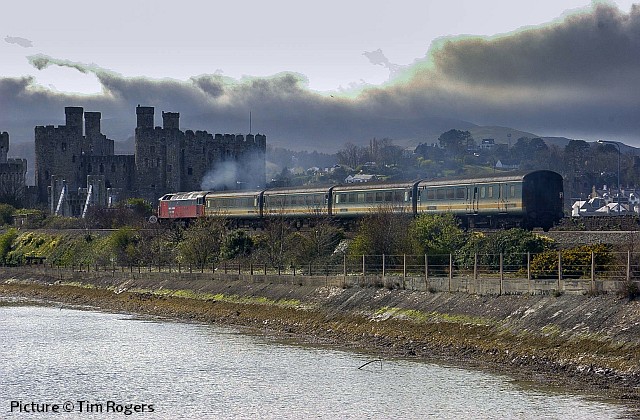
On 3 April 2003 EWS 47 732 Restormel crosses Conwy cob with 1D71 12:21 Birmingham New Street to Holyhead First North Western service formed of First Great Western carriages. Picture by Tim Rogers.
More history to enjoy - and more to come! - Charlie
The last scheduled 37/4 haulage - remembered by Ian Bowland
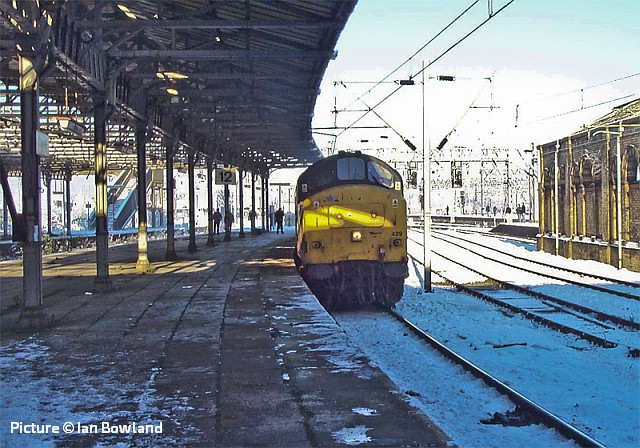
30 December 2000, Crewe station, platform 12 and the thermometer was showing minus seven degrees Celsius. It was to be the final scheduled day for 37/4 operations on the coast and 1G96, the 07.49 Holyhead-Birmingham service was eagerly awaited. The train finally arrived and was already running 40 minutes down, at the head was coastal favourite 37 429 Eisteddfod Genedlaethol in fading Regional Railways livery.
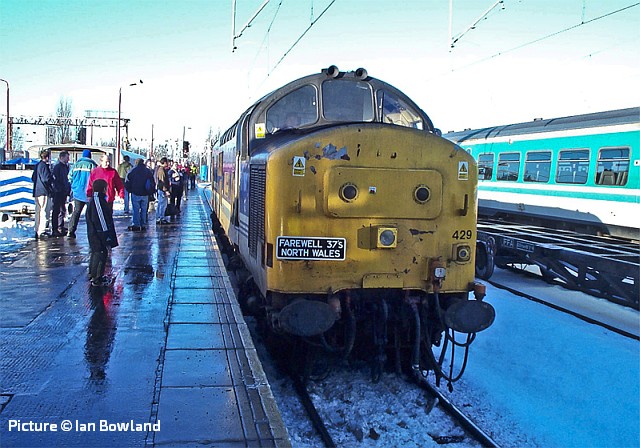
The train only made it as far as Wolverhampton where it was terminated to form 1D71 for Holyhead. Above, 429 reversing onto 1D71 at Wolverhampton after the train had been terminated having lost so much time. The headboard must have been acquired at Crewe or Stafford.While paused at Crewe for the onward run to Holyhead, over the P.A. system came the request, "due to the special nature of the train, would normal passengers cross to platform nine where an alternative service is waiting" (a class 175 'hippo').
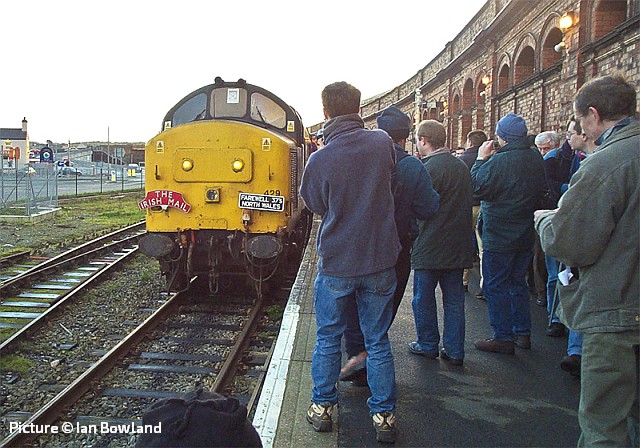
Running round the train at Holyhead; by now the loco had acquired an "Irish Mail" headboard ...
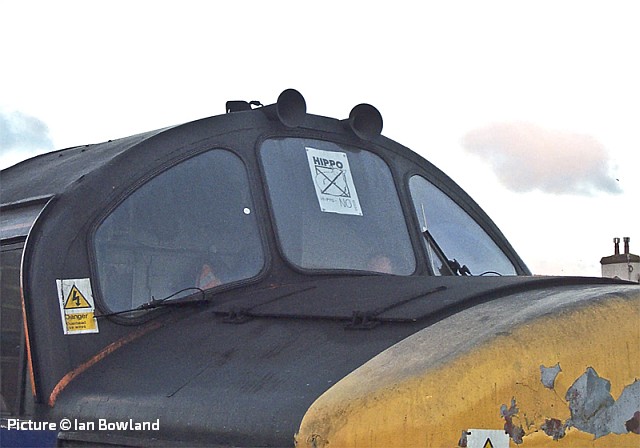
... together with an anti-hippo poster on the windscreen.
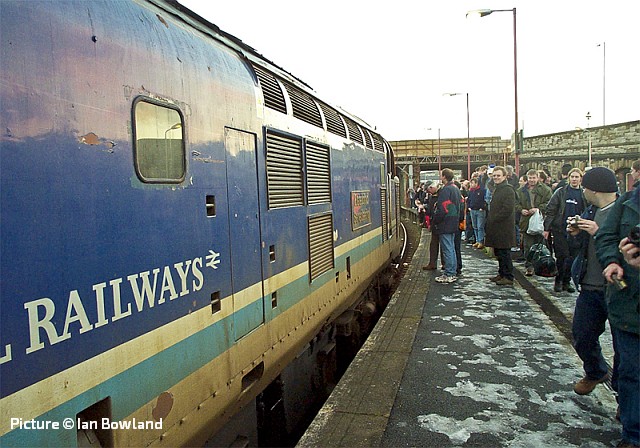
The platform at Holyhead is very narrow and it was impossible to get any clear shots of 37 429 due to the crowd, maybe someone will recognise themselves? Note the familiar red undercoat visible on the nameplate.
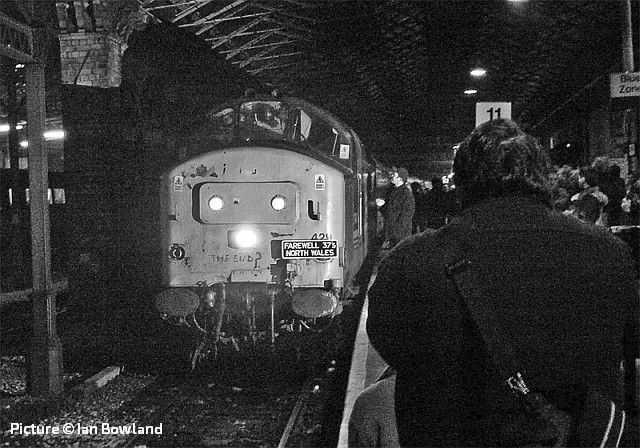
Arrival back at Crewe where the crowd called for a spirited departure but, because there were so many people on the platform, 429 departed with a whimper. Twenty years ago digital cameras were very much in their infancy and unable to cope well with darkness.
Records show that in fact there were further forays along the coast for the 37/4's with 429 making its final run on 20th January 2001. Sadly this locomotive didn't make it into preservation and was cut up by EMR on 8 February 2008 with over 9000 hours 'on the clock'.
North Wales Class 37 Farewell - DVD review
To celebrate the 20th anniversary of the end of 37s, the 'Videoscene' company has released a DVD of scenes from the final year, 2000. We have bought a copy to watch in the long hours of isolation, and very good it is too. There are three sections to the 75-minute program: general views at many locations including the line down to Birmingham; The May 2000 'farewell special', and the Final Day.
There's a spoken introduction, but after that, un-adulterated train sounds with captions to each clip. A booklet with full details of the workings and of each train shown. This is - in our opinion - exactly what is needed in a production like this. If it is to be watched more than once, spoken commentary becomes an irritation.
Available on-line from the Videoscene website for £14.95.
When the Voyager Came to Town - by Eryl Crump
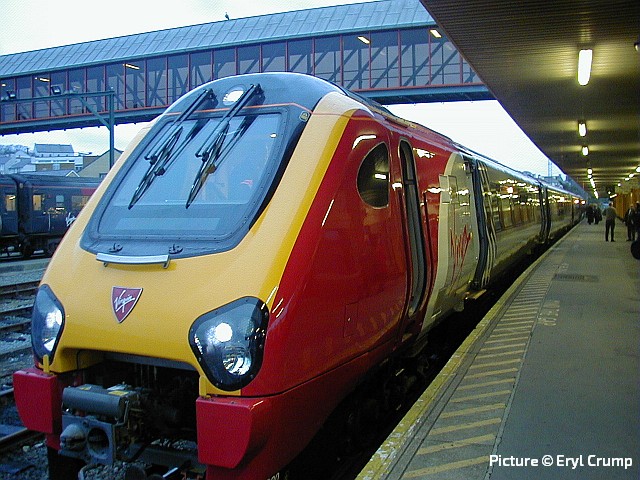
It was 23 November 2001 when the first Virgin Voyager travelled along the North Wales line to Holyhead. It was some months before regular services began but Virgin brought the DMU to show off to local dignitaries (and me!).
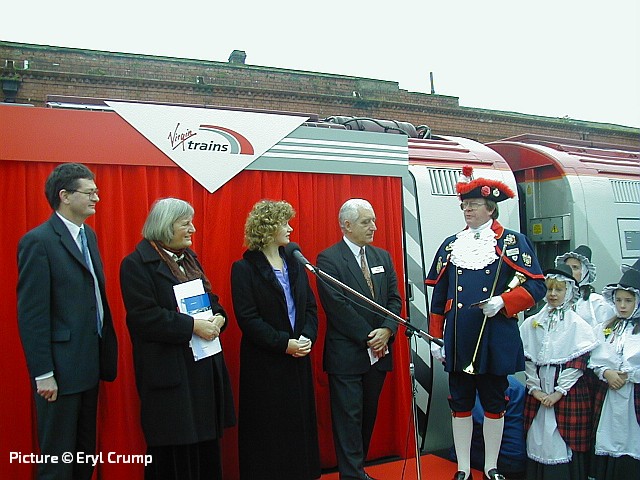
It was given a civic send-off at Holyhead ...
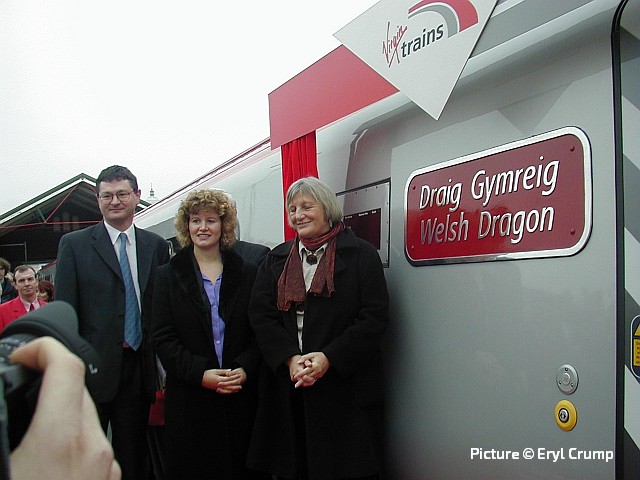
... and made its way to Llandudno where 220 008 was named Draig Gymreig/Welsh Dragon.
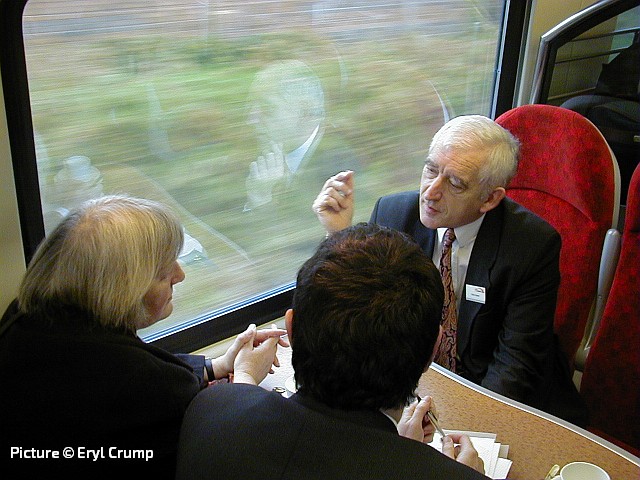
VT brought up Chris Green to introduce the train to Welsh Assembly officials which include the then Transport Minister Sue Essex.
I recall the day well as I had returned to London from Marrakech the previous day and made my way from Heathrow to Euston to catch the 18:10 (or thereabouts) VT service to Crewe and Bangor. Sitting in the train, departure time came but no movement so I went to the doorway and saw a gaggle of people at the head of the train. Walking along the platform I saw there was no loco. It would have been a Class 87. A would-be passenger asked the shunter where the loco was. In blunt Cockney style he said: "It's f*@%^d son, high time we got some new 'uns".
It was then I realised Chris Green was among the knot of people along with Anglesey MP Albert Owen. "Shush!" said Green, "don't want the press to know." "Too late," said Owen introducing me to him.
Chester oldies - by Paul Shannon
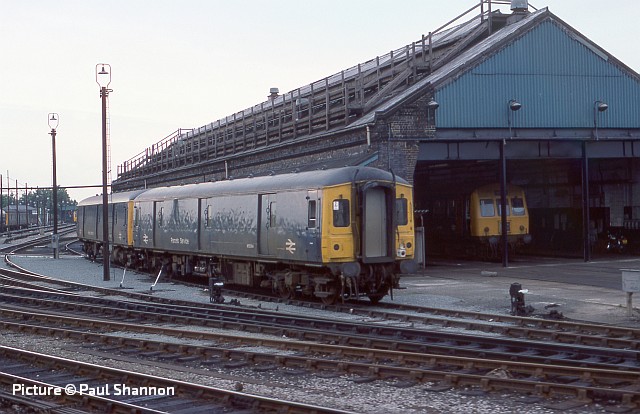
12 June 1977: Parcels unit M55994 and a sister unit in sidings outside Chester diesel depot.
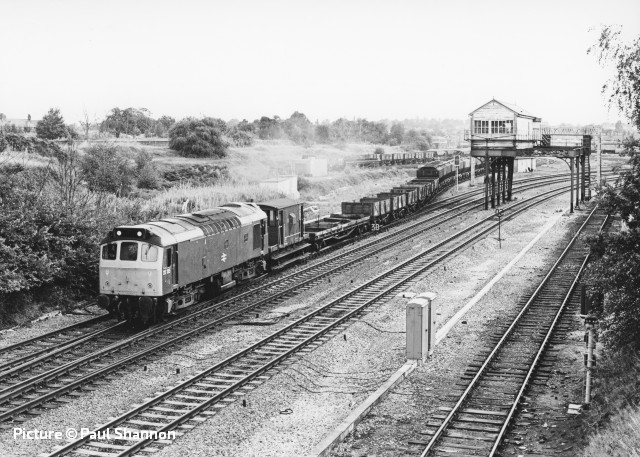
On 13 August 1982 25 135 passes Chester No.6 signalbox with a train of condemned wagons including a number of 'Covhops'.
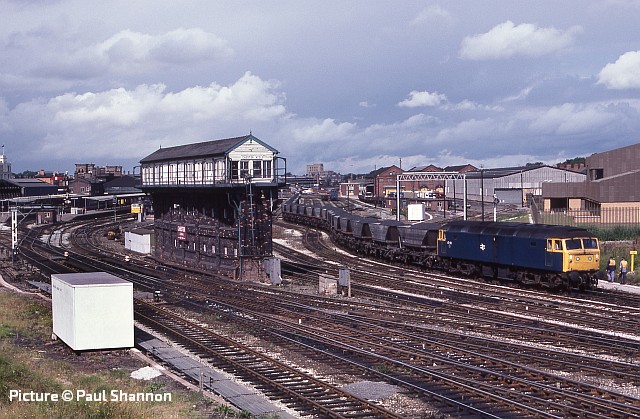
Chester No.2, the largest of Chester's boxes, was nearing the end of its life (demolished 1984) on 13 August 1982 as 47 182 passes with a train of 'merry-go-round' coal hoppers from either Bersham or Point of Ayr colliery.
Ffestiniog Flyer - recalled by Ken Robinson
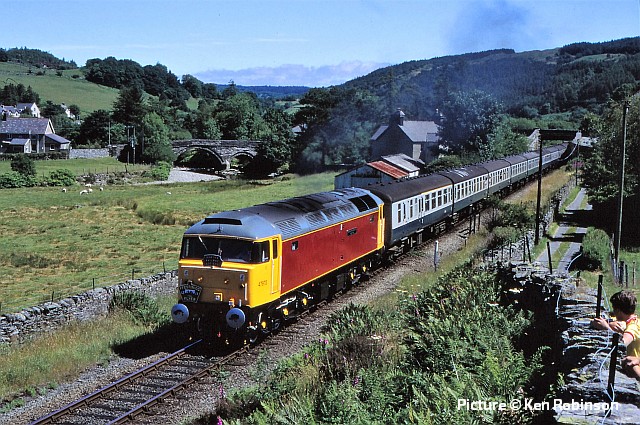
In these dark and difficult times I thought something 'colourful' might brighten things up, and came up with these: Above, 47 973 passes Dolwyddelen on 16 July 1989 with Burton Railway Society's 'Ffestiniog Flyer'.
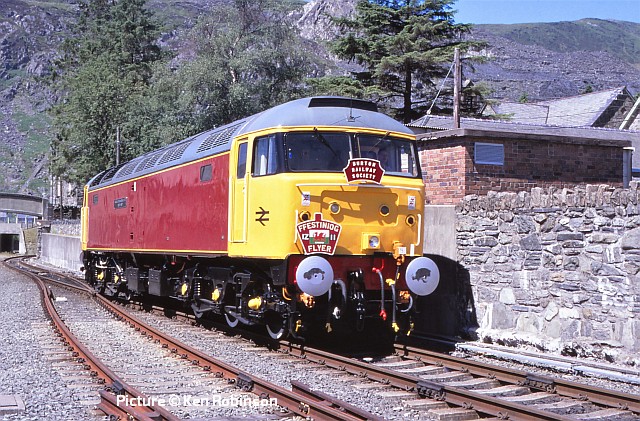
At Blaenau Ffestiniog the loco runs round its train - it carried the name Midland Counties 150 1839-1989 during this period, and a livery to match, which became known as Midland Counties Maroon. The odd livery came about when the loco was allocated for use by the Railway Technical Centre at Derby.
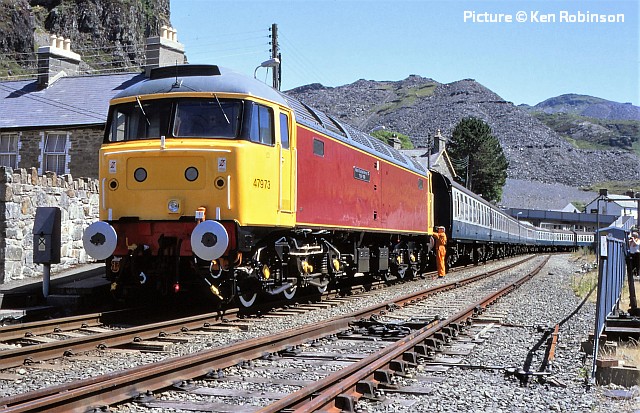
47 973 backs onto its stock ready to move the train into the loop. The Midland Counties Railway, which only existed as an independent company from 1839 to 1844, connected Derby and Nottingham with Leicester and Rugby; it was one of the constituents of the Midland Railway which operated until 1923. It was on the Midland Counties line that Thomas Cook famously ran his first excursion train, from Leicester to Loughborough in 1841.
Chester variety, 5 April 2001 - pictures by Tim Rogers
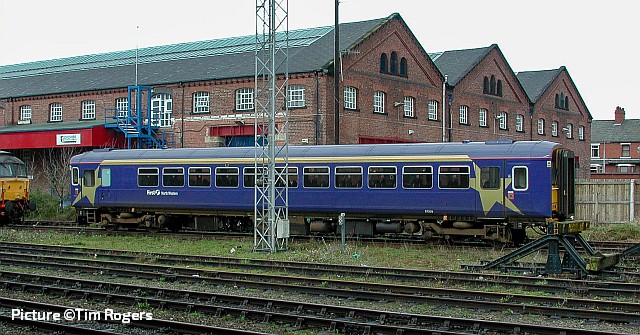
With Chester's large (former) goods warehouse in the background, First North Western 153 359 stands in the sidings. When FirstGroup took over the franchise from short-lived North Western Trains, they retained the latter's livery with its gold stars for inherited diesel units.
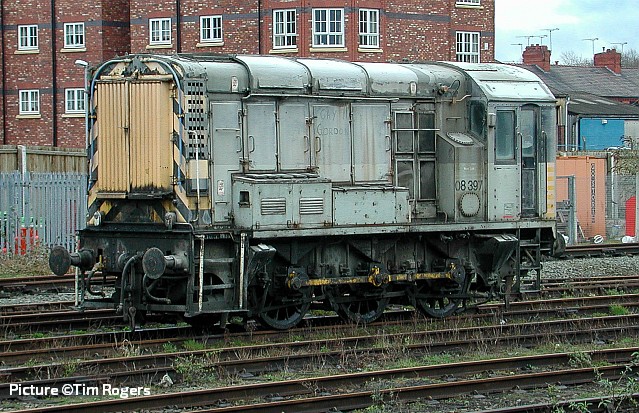
Also in the sidings, 47 705 Guy Fawkes, from the Waterman Railways fleet. The legend is that when Waterman Railways was set up, by purchasing BR's 'Special Trains Unit' during the privatisation era, Mr Waterman bought locomotives for the range of excursions he was gong to run, on the assumption that the Government was making him the sole charter operator. When he discovered that there was an 'open market', Guy Fawkes was included in his list of loco names.
Looking back with David Pool - Amlwch traffic
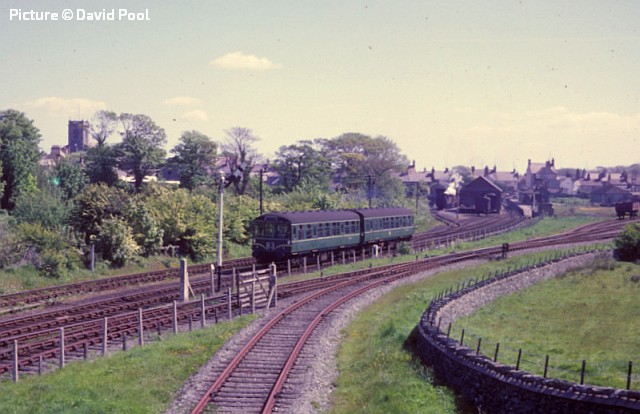
At Amlwch on 31 May 1962 class 104 unit M50532/M56175 was leaving on the 10:45 to Bangor, with 2-6-2T 41233 in the goods siding. Passenger services ceased in 1964.
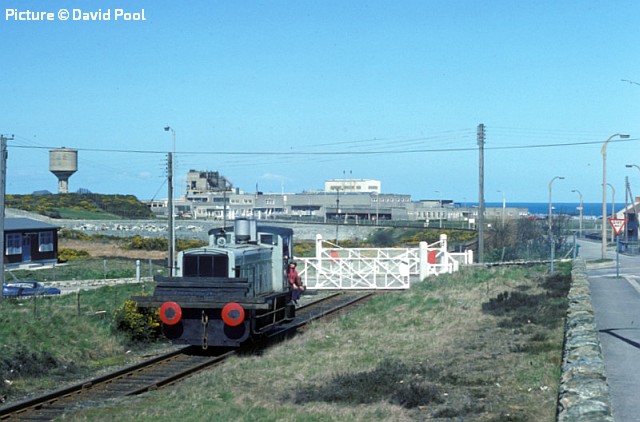
Fifteen years later on 15 April 1977, Associated Octel No.4, a Ruston & Hornsby diesel ... was waiting for the arrival of a freight train, probably from Ellesmere Port.
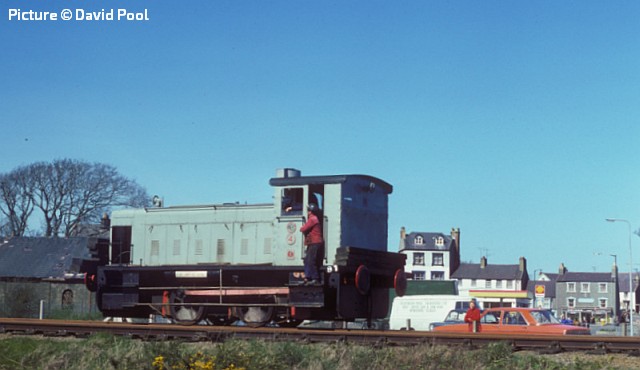
... was waiting for the arrival of a freight train, probably from Ellesmere Port.
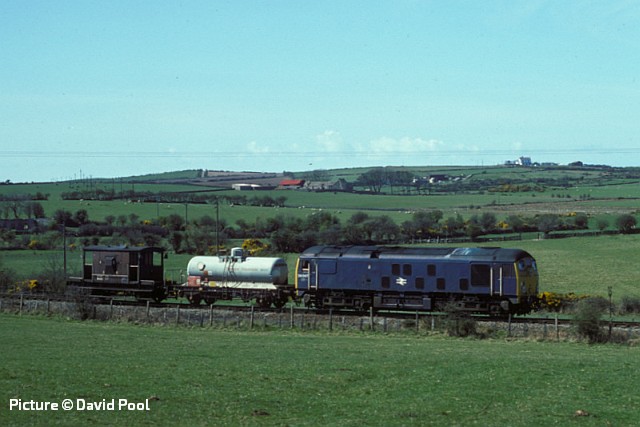
The incoming train consisted of a single empty Ethylene Dibromide tank and a brake van, hauled by 24 047.
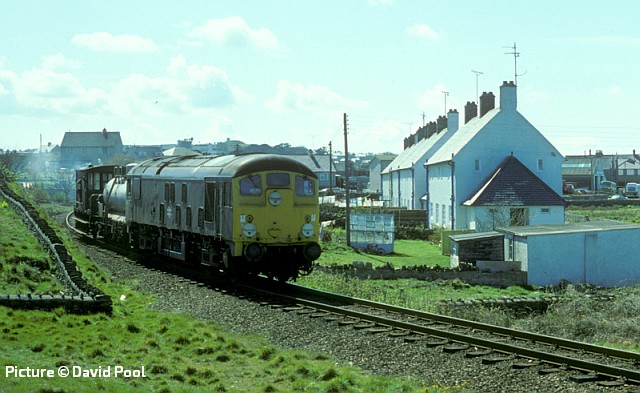
It made its way into the AOC plant along the private line beyond the level crossing.
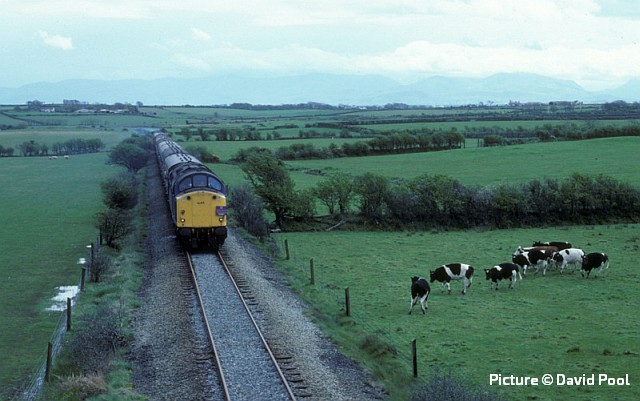
On 14 May 1983 the 'Amlwch Pioneer' railtour ran from Euston (1Z10 departing at 07:28), and from Crewe was hauled by 40 058 with 40 034 on the rear. The cows in the field between Llangwyllog and Llanerchymedd were excited to see the two Class 40s!
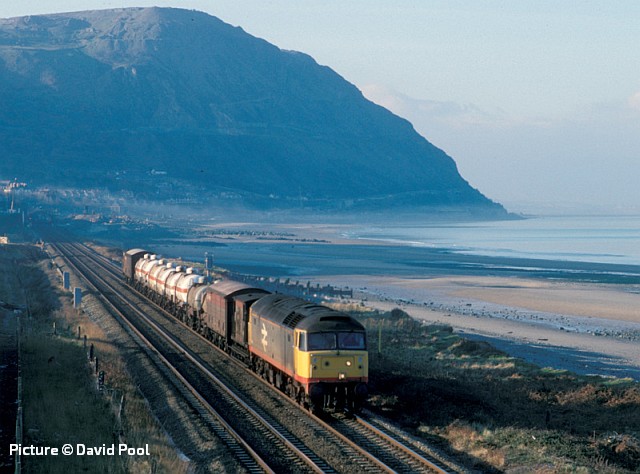
In 1988 freights were still running regularly, and on 16 November the early morning train 7D05 from Amlwch to Llandudno Junction was photographed at Penmaenmawr, consisting of 47 227, two Ethylene Dibromide and six Chlorine tanks, a pair of VDA barrier vans and a couple of brake vans.
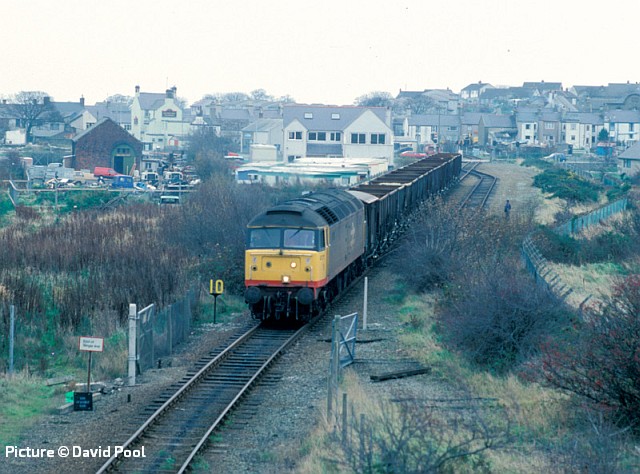
47 227 then returned to Amlwch to collect a rake of empty Sulphur wagons, leaving at noon for Mostyn Dock. The goods shed is visible, now in the middle of a car park, but there is no sign of the station. In 1993 all traffic on the line ceased.
Freight, 1980 - by David Rapson
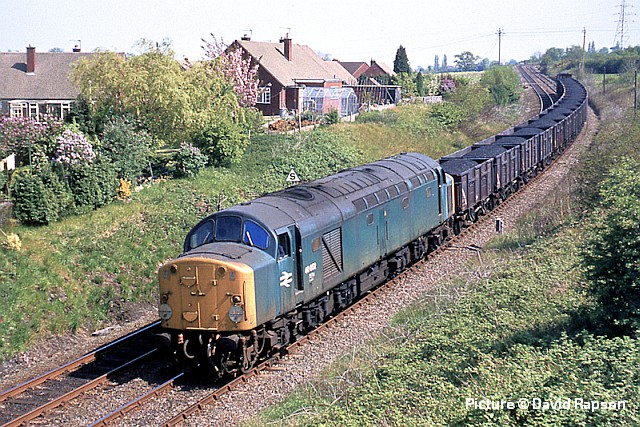
These images were all taken in 1980 (40 years ago!) when I was working at Dee Marsh in the TOPS Office and literally had the run of the railway. Above, EE Type 4 40 052 drifts down the bank from Hawarden towards Shotton at Ewloe with 8F75 14:20 Bersham Colliery - Shotwick Sidings coal (14 May 1980).
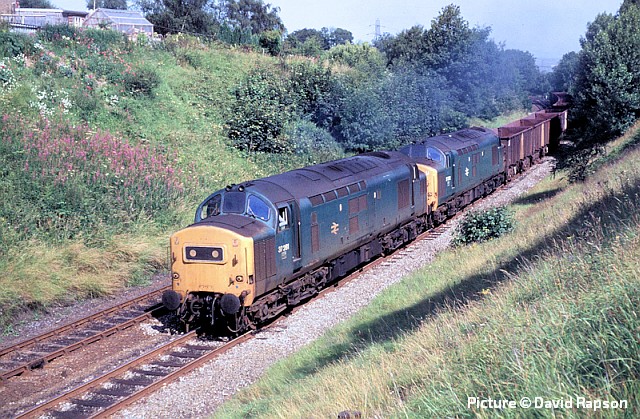
With 1,000 tonnes of iron ore in tow EE type 3s 37 281 and 37 302 create quite a din on the climb towards Hawarden station with 6X51 09:00 Shotwick Sidings to Llanwern (24 July 1980).The ore had been stockpiled at BSC Shotton following the steel strike and was moved to South Wales once steel-making ceased on Deeside.
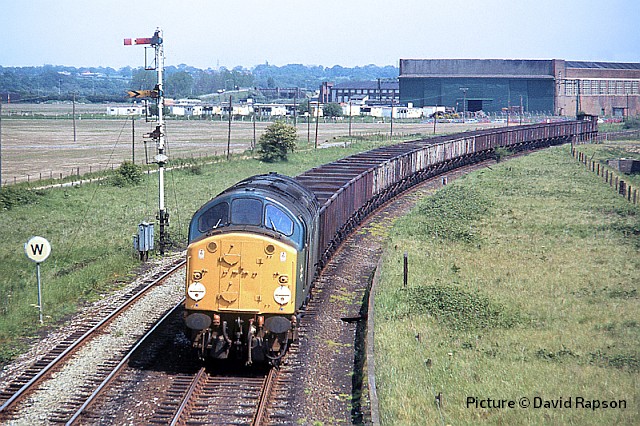
Dee Marsh Junction to Mickle Trafford was still a relatively well-used line in 1980. 40 022 has charge of 8L40 13:00 Garston - Dee Marsh minerals on 3 June 1980).The driver of 40 022 picked me up and gave me a lift back to the office!
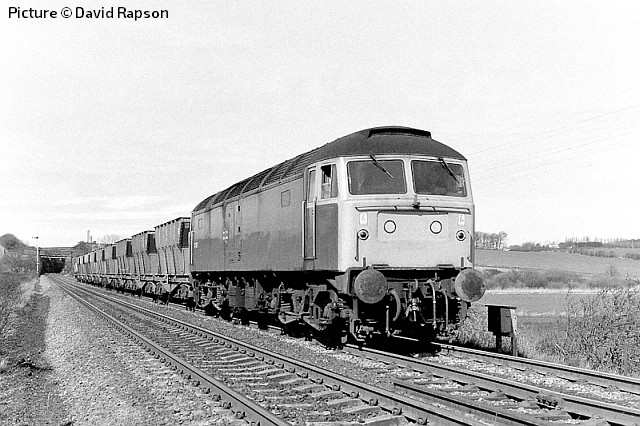
Forty years ago the last train of iron ore ran from Bidston to Shotwick. 47 367 is hauling nine BSC hoppers plus a brake van forming 9T00 13:00 Bidston Dock - Shotwick Sidings (2nd April 1980).
Looking back: Dunham-on-the-Hill 1965 - with Peter Neve
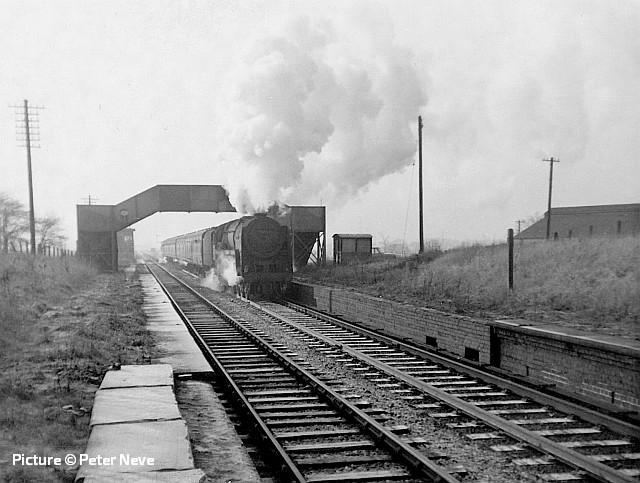
Some more images of the steam era taken at Dunham-on-the-Hill in 1965. At the time, Single Line Working was in operation between Dunham-on-the-Hill and Helsby due to engineering work on the Down line. Trains from Chester would have to stop at the disused Down platform at the station (closed to passengers in 1952), take on board a pilotman and then reverse back on to the Up line. The following sequence of photographs illustrate the operational conditions prevailing at the time.
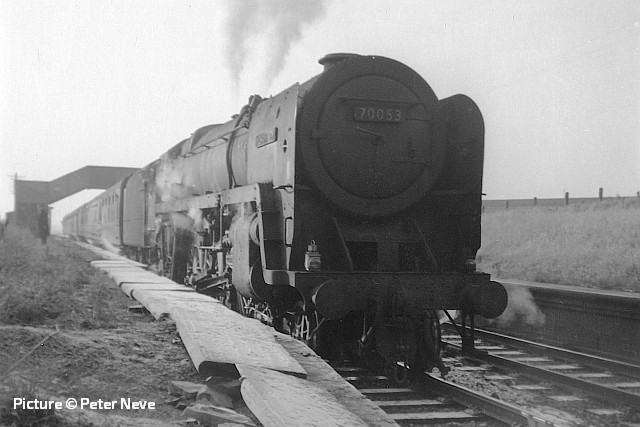
On a cold and frosty February morning the sun catches the exhaust from the chimney and safety valves of Britannia Class 4-6-2 70053 Moray Firth. The train will stop at the disused platform, reverse back on to the Up platform and continue on its journey to Helsby.
With steam still escaping profusely from the safety valves, 70053 stands in the Up platform waiting for the pilotman to board the engine. He can just be seen in the dark coat standing in front of the footbridge staircase. The lamp arrangement on the front of the engine indicates it is hauling an express passenger train.
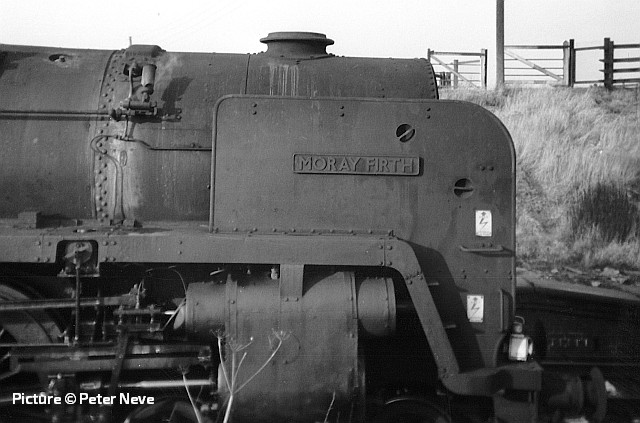
A close up of the front end of the Britannia showing the whistle and nameplate. All 55 locomotives of the class were in service at this time. The first to be withdrawn was 70007 Coeur-de-Lion in June 1965.
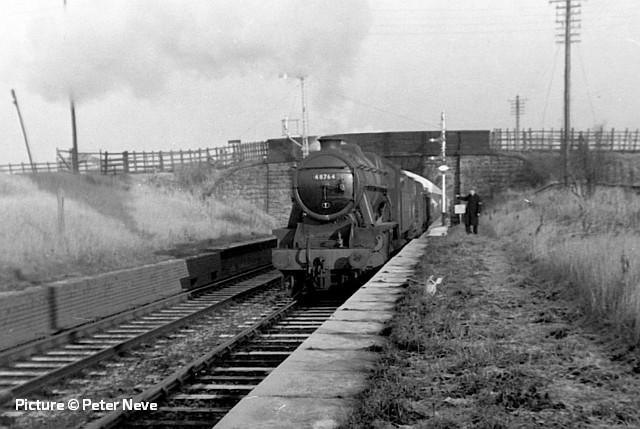
The crew of Stanier 8F 2-8-0 48764 has just returned the pilotman (note the white armband) back to Dunham-on-the-Hill station ready for his next departure to Helsby. The mixed freight train will continue on to Chester. Note the smaller, subsidiary semaphore signals in front of the bridge. 48764 was withdrawn from Bolton shed in December 1967.
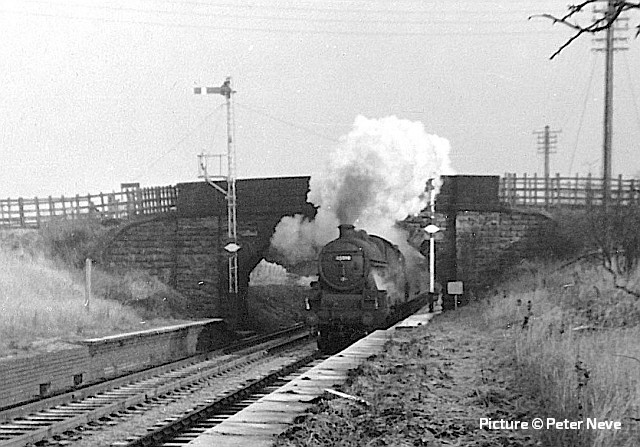
Jubilee Class 4-6-0 45590 Travancore bursts from underneath Hob Lane bridge with an express passenger train bound for Chester. With the train travelling at line speed, the experience was exhilarating, if not a little frightening! The engine was based at Warrington Dallam (8B), was withdrawn in December 1965 and broken up at Cashmores at Great Bridge in 1966.
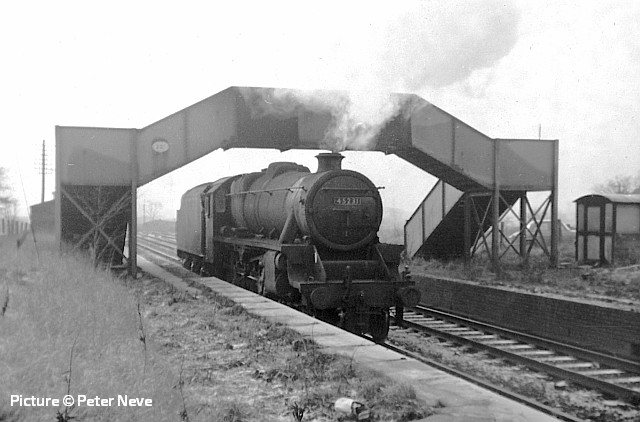
Chester 6A-based Stanier 4-6-0 'Black 5' 45231 drifts light-engine through Dunham-on-the-Hill station on its way back to its home shed. This locomotive survived the cutter’s torch and now performs on the mainline, often seen between Crewe, Chester and Shrewsbury. It is based at Crewe and is named The Sherwood Forester.
April 2003 , Llandudno Junction - pictures by Tim Rogers
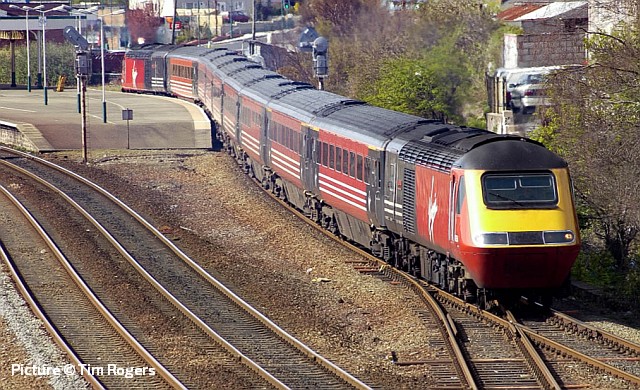
43 154 Intercity and 43 084 County of Derbyshire on 1A77 13:43 Holyhead to Euston.
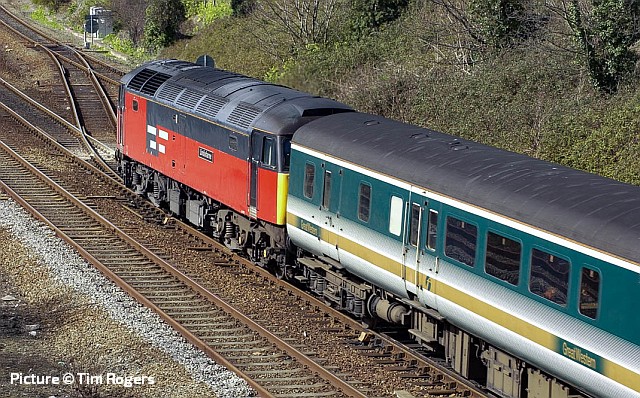
47 789 Lindisfarne on First North Western 1D71 12:21 Birmingham New Street to Holyhead
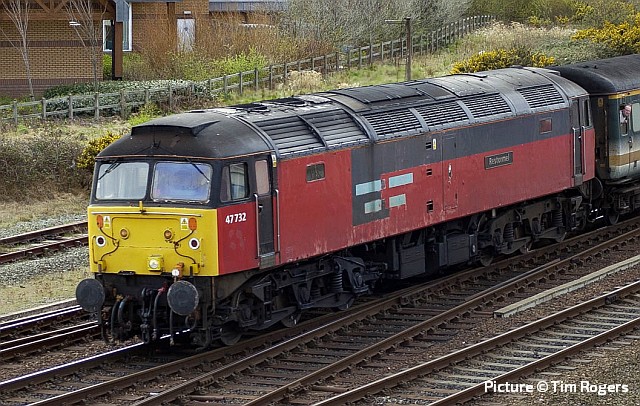
47 732 Restormel works 1G11 14:00 Holyhead to Birmingham New Street.
60s Steam selection - pictures by Peter Jump
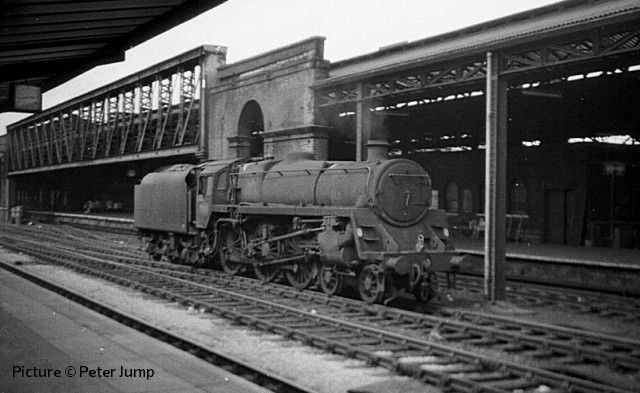
These pictures were taken in the mid 1960s; any further information would be welcome. Abobe, a 'Caprotti' Standard class 5 4-6-0 (number unknown) at Chester.
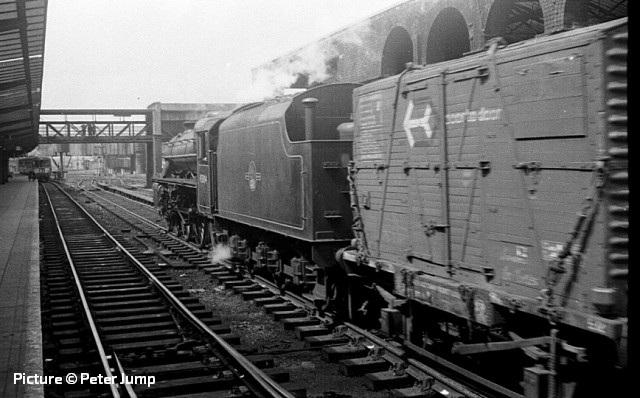
A 'Black 5 ' on freight at Chester; and a good view of a 'Conflat A' wagon with Type B container.
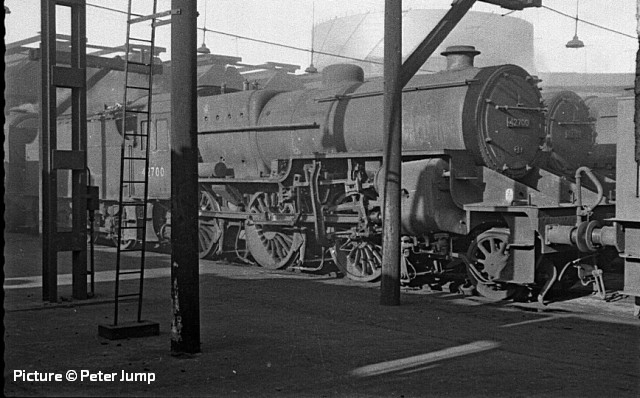
'Crab' 42700 on Birkenhead shed.
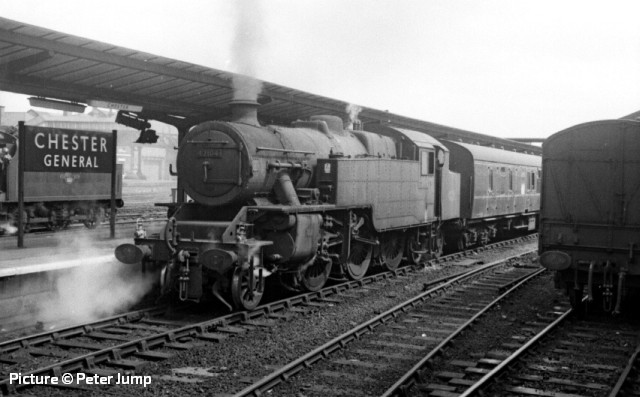
Fairburn 4MT tank 42104 at Chester.
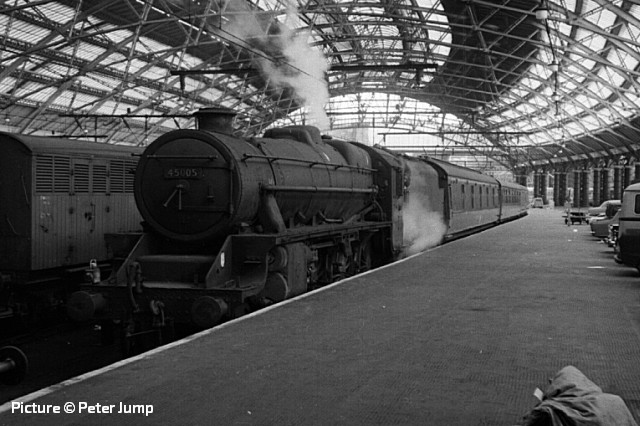
'Black 5' 45005 at Liverpool Lime Street on what is thought to be is the Glasgow - Liverpool sleeper train, steam hauled from Preston.
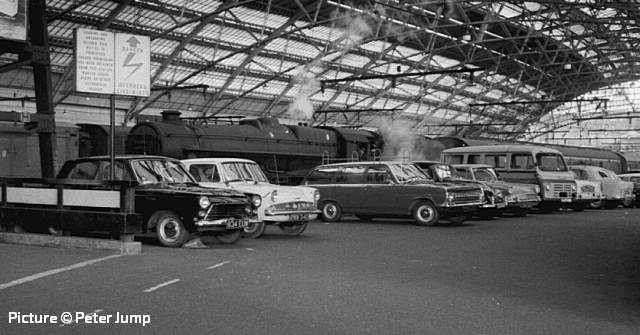
A nice array of classic cars parked by platform 6.
Parry's Railway Companion from Chester to Holyhead - Part 2
Transcribed by Geraint Rowlands
[Today's extract sees us start off on our journey, as Edward Parry reassures us that we will have a safe journey...]
We will now suppose that the traveller and the "Railway Companion" have been introduced and are in a mood to enjoy each other's conversation relative to the scenery and the beauties of the intended trip through Wales. The warning bell has rung; our fellow-passengers hasten to take their seats, the steam issues in dense silver masses, and the engine already is in motion.
Now science, burning in her modern way, Propels the power, and bids the piston play.
We had not been many seconds on our way before we heard the loud and shrill railway whistle, announcing our approach to the tunnel, 300 yards long, under Northgate-street and the adjacent gardens, into which the carriages immediately enter, and emerge through deep cuttings of red rock. The train winds its way over the girder bridge crossing the Ellesmere and Chester Canal, dashes through the west angle of the City Walls, and enters on the high 'and long embankment over the Tower-field and crosses the two Crane-streets. The line is here carried on a viaduct of forty-seven arches.
On the left is the far-famed ROODEE, where the celebrated Chester races take place in the spring and autumn of every year. This beautiful piece of ground is nearly encircled by the River Dee on the one part and the City Walls on the other. The genteel houses lately built on the elevated ground called Curzon Cresent, ending with Grosvenor Bridge and its gigantic arch on the one side, and the Chester and Holyhead Railway Viaduct on the other, gives the Roodee the appearance of a splendid amphitheatre, enclosing an area of about 84 acres of rich meadow land; these, together with a view of Chester Castle, St. Bridget's Church, and the Grosvenor Grand Lodge, add considerably to the beauty of this interesting and animating scenery, —particularly at the time of the races, which are second to none in the kingdom. The number of horses entered for the tradesmen's cup in 1848 was no less than 156, out of which 106 accepted, being by far the largest number on record for one race in this or any other country: the handicapping, by Mr. W. E. Topham, gave great satisfaction; 34 started for the rich prize, and the owner of the winner (Peep-o'-Day Boy) received the stakes, amounting to £2500. The entry for 1849 exceeded 200, and 108 accepted.
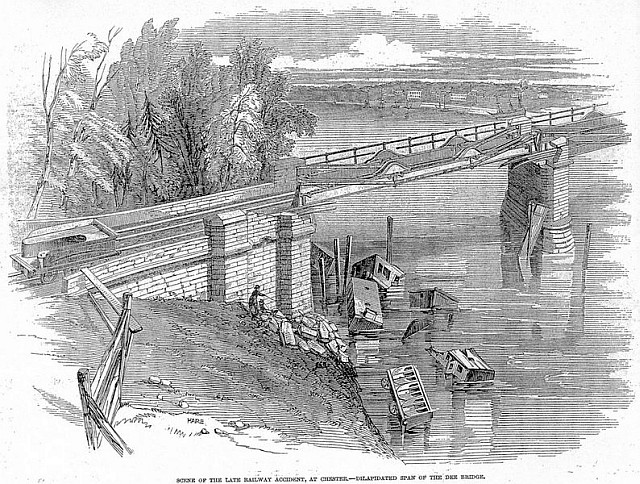
The railway carriages cross THE RIVER DEE On the largest cast-iron girder-bridge in the kingdom. One of the girders broke in two while the train was passing over on the 24th of May, 1847, a day never to be forgotten in the city of Chester, from the dreadful crash and awful accident that took place on the occasion: four lives were lost, and a great many maimed and injured. Since then, every means have been employed by the company to make the bridge as secure as possible. The government engineer has examined it, tested its strength, and pronounced it safe; and now the public are generally satisfied of its stability.
All the ancient authors who have written on the city of Chester, have attached high importance to the river Dee, as affording facility to its trade and commerce, as well as the primitive source of its greatness and renown. It formerly made Chester the receptacle of merchandise from all kingdoms and nations who traded in the British and Irish Ocean, and became the very key and inlet from which not only the Romans, but the Saxons and Normans in their time, made the passage to and from Ireland. There is no river in England which has been so much celebrated by our poets for its sanctity as the Dee.
North Wales Coast home page | Archive | Previous Notice Board